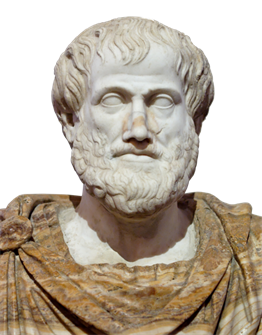
PUMPA - SMART LEARNING
எங்கள் ஆசிரியர்களுடன் 1-ஆன்-1 ஆலோசனை நேரத்தைப் பெறுங்கள். டாப்பர் ஆவதற்கு நாங்கள் பயிற்சி அளிப்போம்
Book Free DemoThe basis of classification:
The attempt of classifying living organisms is being made from ancient times. Aristotle is a Greek thinker who classified living organisms based on their habitat. Though this method of classifying living organisms was very simple, it was misleading.

Greek Philosopher - Aristotle
This classification given by Aristotle was a misleading one as the animals that live in the oceans and seas include the corals, whales, octopuses, starfish and sharks, which are very different from each other in a variety of ways. This proves that the living organisms should not be classified by only considering their habitat.
The classification of living organisms into broad divisions is based on their characteristics. Then the next set of characteristics is used for dividing these broad divisions into sub-groups.
Definition of characteristic
The particular feature or a specific function of an organism or an object is known as its characteristic.
Example:
Most of the humans have five fingers on each of their hands. Thus, it is an example of characteristic. Humans and most animals can run, but plants is also a characteristic.
The construction of a stone wall with a variety of stones with different shapes and sizes can be used as a reference in understanding how some characteristics are decided as being more fundamental than others.
This is because the stones found at the top of the wall will nowhere affect the of stones that come below them. But the sizes and shapes of the stone at the lowermost layer determines the shape and size of the next layer and so on.
The stones at the lowermost layer are compared to the characteristics that decide the broadest divisions among living organisms, and these characteristics are independent of any other characteristics pertaining to the forms and functions of the organisms. The characteristics of a particular level is dependent on the previous one and also decides the variations in the next level. Hence in this way, the whole hierarchy of mutually related characteristics to be used for classification is built up.
Some of the characteristics that are used in the classification of living organisms are as follows:
- Classification based on the presence and absence of membrane-bound cell organelles, i.e., whether an organism is a eukaryote or prokaryote. As the eukaryotes have a cell with a well-defined nucleus, the cellular processes in them occur efficiently in isolation from each other. These cells also have the capacity to participate in forming a multicellular organism. Thus, nucleus serves as a basic characteristic of classification.
- Classification based on the number of cells, i.e., whether an organism is unicellular or multicellular. In multicellular organisms, all the cells are not identical. Groups of cells carry out specialised functions. This leads to the distinction of body designs of organisms.
- Based on the factor of whether an organism can prepare its food or not, the organisms are classified into autotrophs and heterotrophs. The organisms which can prepare their own food are known as autotrophs, and the organisms which cannot prepare and depend on other organisms are known as heterotrophs.
- Based on the development of the body, their parts and organs which perform different functions.
When considering body design as a characteristic, the classification of plants is very different from the classification of animals as their basic designs are different. Thus, these features are used to make sub-groups rather than making broad groups.
Reference:
https://upload.wikimedia.org/wikipedia/commons/thumb/5/57/Aristotle_transparent.png/512px-Aristotle_transparent.png